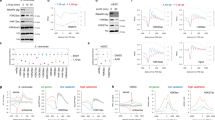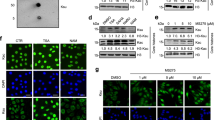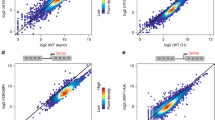Abstract
Nucleosome depletion in the promoters has been indicated in yeasts, suggesting that nucleosome depletion in promoter might be a fundamental feature of eukaryotic transcriptional regulation. We compared the relationship between histone H3 acetylation at lysine 9 (K9) in promoter, gene expression level, and nucleosome density in the vicinity of the transcription start site (TSS), in HepG2 cells (human hepatocellular liver carcinoma cells). We found that the density of nucleosome is relatively low in the close vicinity of TSS flanked by H3 K9 significantly acetylated promoter, compared with that for genes without marked H3 K9 acetylation in promoter, regardless of their transcriptional activation status. Our results imply that the relative nucleosome depletion in the vicinity of TSS is not necessarily associated with active transcription, but with histone H3 K9 acetylation in promoter.





Similar content being viewed by others
References
Bernstein BE, Kamal M, Lindblad-Toh K et al. (2005) Genomic maps and comparative analysis of histone modifications in human and mouse. Cell 120: 169–181.
Bernstein BE, Liu CL, Humphrey EL et al. (2004) Global nucleosome occupancy in yeast. Genome Biol 5: R62.
Cawley S, Bekiranov S, Ng HH et al. (2004) Unbiased mapping of transcription factor binding sites along human chromosomes 21 and 22 points to widespread regulation of noncoding RNAs. Cell 116: 499–509.
Cheng J, Kapranov P, Drenkow J et al. (2005) Transcriptional maps of 10 human chromosomes at 5-nucleotide resolution. Science 308: 1149–1154.
Florea L, Hartzell G, Zhang Z et al. (1999) A computer program for aligning a cDNA sequence with a genomic DNA sequence. Genome Res 8: 967–974.
Gilbert N, Boyle S, Fiegler H et al. (2004) Chromatin architecture of the human genome: gene-rich domains are enriched in open chromatin fibers. Cell 118: 555–566.
Jenuwein T, Allis CD (2001) Translating the histone code. Science 293: 1074–1080.
Kampa D, Cheng J, Kapranov P et al. (2004) Novel RNAs identified an in-depth analysis of the transcriptome of human chromosomes 21 and 22. Genome Res 14: 331–342.
Kapranov P, Cawley SE, Drenkow J et al. (2002) Large-scale transcriptional activity in chromosomes 21 and 22. Science 296: 916–919.
Kent W (2002) BLAT: the BLAST-like alignment tool. Genome Res 12: 656–664.
Lee C-K, Shibata Y, Rao B et al. (2004) Evidence for nucleosome depletion at active regulatory regions genome-wide. Nat Genet 36: 900–905.
Li T, Vu TH, Ulaner GA et al. (2004) Activating and silencing histone modifications form independent allelic switch regions in the imprinted Gnas gene. Hum Mol Genet 13: 741–750.
Liang G, Lin JCY, Wei V et al. (2004) Distinct localization of histone H3 acetylation and H3-K4 methylation to the transcription start sites in the human genome. Proc Natl Acad Sci USA 101: 7357–7362.
Liu CL, Kaplan T, Kim M et al. (2005) Single-nucleosome mapping of histone modifications in S. cerevisiae. PLoS Biol 3: e328.
Mueller PR, Wold B (1989) In vivo footprinting of a muscle specific enhancer by ligation-mediated PCR. Science 246: 780–786.
Ren B, Robert F, Wyrick JJ et al. (2000) Genome-wide location and function of DNA binding proteins. Science 290: 2306–2309.
Rice JC, Allis CD (2001) Histone methylation versus histone acetylation: new insights into epigenetic regulation. Curr Opin Cell Biol 13: 263–273.
Roh T-Y, Cuddapah S, Zhao K (2005) Active chromatin domains are defined by acetylation islands revealed by genome-wide mapping. Genes Dev 19: 542–552.
Sekinger EA, Moqtaderi Z, Struhl K (2005) Intrinsic histone-DNA interaction and low nucleosome density are important for preferential accessibility of promoter regions in yeast. Mol Cell 18: 735–748.
Strahl BD, Allis CD (2000) The language of covalent histone modifications. Nature 403: 41–45.
Acknowledgements
We thank Tom Gingeras and his research group in Affymetrix, Affymetrix Japan, Harukazu Suzuki, Jun Kawai, and Haruhiko Koseki for helpful advice and useful suggestions. This work was supported in part by a Research Grant for the Genome Network Project and a Research Grant for the RIKEN Genome Exploration Research Project from the Ministry of Education, Culture, Sports, Science and Technology of the Japanese Government, a Research Grant for Advanced and Innovational Research Program in Life Science, and the Strategic Programs for R&D of Riken to Y.H.
Author information
Authors and Affiliations
Corresponding author
Additional information
†These authors contributed equally to this work.
Electronic Supplementary Material
Rights and permissions
About this article
Cite this article
Nishida, H., Suzuki, T., Kondo, S. et al. Histone H3 acetylated at lysine 9 in promoter is associated with low nucleosome density in the vicinity of transcription start site in human cell. Chromosome Res 14, 203–211 (2006). https://doi.org/10.1007/s10577-006-1036-7
Received:
Accepted:
Published:
Issue Date:
DOI: https://doi.org/10.1007/s10577-006-1036-7




